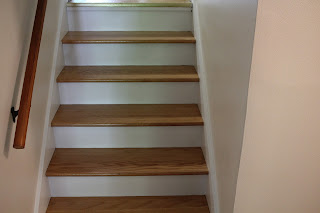Surprise projects are always the best projects and we had a bit of a surprise on Friday: two leaks on the well pressure tank. I knew we had pinhole leaks on the old galvanized tank but there were just damp and never had dripped or anything so I figured we could hold off on a new tank for a while. I was wrong. Friday we found the holes dripping quite a bit and decided to try and patch it for the time being. I started by turning off the well pump, closing the main valves for the house, and draining the tank.
 |
| Both leaks in the front. |
 |
| Draining the tank with the ShopVac hose. |
As the water level lowered, I started to clean up the holes for the patching I would do. There was a lot of mineral buildup on the outside of the tank so I scrubbed it with a wire brush to give me a clean surface to work with. This was a bad idea at the time because as soon as the mineral buildup flaked off the leak got worse and water was streaming out. Oh well, the floor drain will catch it all.
 |
| Cleaned up and drained. |
I had several plans for patching and the first was to use a Neoprene washer on a self tapping screw that I would drive into the holes. Both holes crumbled when I attempted to do this and the openings just got bigger. So I had to try my backup plan.
 |
| Larger holes after attempting first fix. |
Plan B was to use JB Weld to close the leaks temporarily until we could get a plumber in during the week to estimate a new tank for us (I'm not paying weekend rates!). I cleaned and dried the area for the patch and mixed up the epoxy. I applied it with an old paint stirring stick and waited for it to cure. Initial curing is supposed to take 5-6 hours so most of my day on Saturday was waiting for this step. After curing, I wrapped the area in duct tape to help hold the pressure and opened all the valves. I turned on the pump and watched as the pressure built. 10 PSI, okay. 20 PSI, okay, 30 PSI some dribbles, crap. 40 PSI a lot of steaming water. JB Weld didn't hold as well as I expected and I didn't have the 16 hours to let it cure fully. I used this time to run some water in the house that we needed to and then turned the pump back off and re-drained the tank. It was late in the day so I waited until Sunday to do the rest of the project: replacing the tank.
 |
| You've failed me for the last time, JB Weld. |
Sunday I started early at 6:30am and began by removing the old tank. This meant turning off the breaker for the pump and removing the electrical connection to the pressure switch, disconnecting the pump supply line, and disconnecting the post-tank line that feeds the house. The pump line had a union joint in it that I could just undo and the house line was PEX so I simply cut that.
 |
| Removed the tank. |
I was going to try to reuse much of the old fittings and valves to save cost but much of it was so corroded or unmoveable I didn't bother. The new tank is setup slightly different too, the outlet is not on the side of the tank as you can see on the old tank but rather it is on the bottom and centrally located so I needed a longer tee valve.
 |
| Old tank. |
I also took this opportunity to install a new whole house filter. I attached a piece of 3/4" plywood to the wall behind the tank area which gave me a good mounting point for the new filter. I bought the
Whirlpool house filter and installed shutoff valves on either side to make it easier to replace the filter. Using PEX tubing, I attached the outlet side to the main house line
 |
| New filter with shutoffs. |
 |
| Outlet connected to house. |
I also used PEX to run a line to where the new tank outlet would be and started assembling the tank fixtures. I bought a
large tank to help reduce the amount of work the pump has to do and extend its life. With much thread tape, I attached the new 13" tee fitting and to that attached the old pressure gauge and pressure switch that controls the pump. A new drain spigot and pressure relief valve completed that assembly.
 |
| New tee. Note the different attachment point under the tank. |
 |
| Gauge, drain, and relief installed. Switch attaches to the 1/4" pipe above the relief valve. |
I moved the tank into position and fitted a new copper elbow to the pump side of the tee. To this I soldered on some 1" pipe and a threaded adapter. This is where a check valve goes so the pressure tank doesn't push water back into the well. I cut the old pipe just above the union joint and installed a new union. I measured the length between the new union and the check valve and cut a length of pipe to fit between them. This pipe got a threaded adapter on the check valve side and the other end of the union joint on the top. The union makes it so you can thread the check valve on after soldering your joints since you don't want to heat it and ruin the rubber gasket inside. With these all assembled I could connect the inlet from the pump to the tank.
 |
| New union and check valve. |
Next was connecting the outlet from the tank to the new house filter I just installed. This was all done with PEX and was pretty straightforward. I made most of my connections before installing since there was limited room to use the crimping tool on the fittings behind the new tank. The last thing to do was to reinstall the pressure switch and connect the electrical. Unfortunately the new tank tee sits lower than the old one so the rigid conduit couldn't reach. I had to go buy new flexible conduit and run 12 gauge wires through it to support the 230v system. With the electrical run and some trial and error figuring out how the pressure switch gets wired the pump turned on and started filling the tank.
 |
| New tank and house filter. |
Success! The union needed a bit of tightening but the system works and we have water in the house again. The house filter already picked out quite a bit of sediment so I'll have to keep an eye on it for replacing. Since the electrical moved I still have to reattach the pump switch to the wall but I need to drill into a solid concrete foundation block to do that. All in all it was a busy but productive Sunday.



































